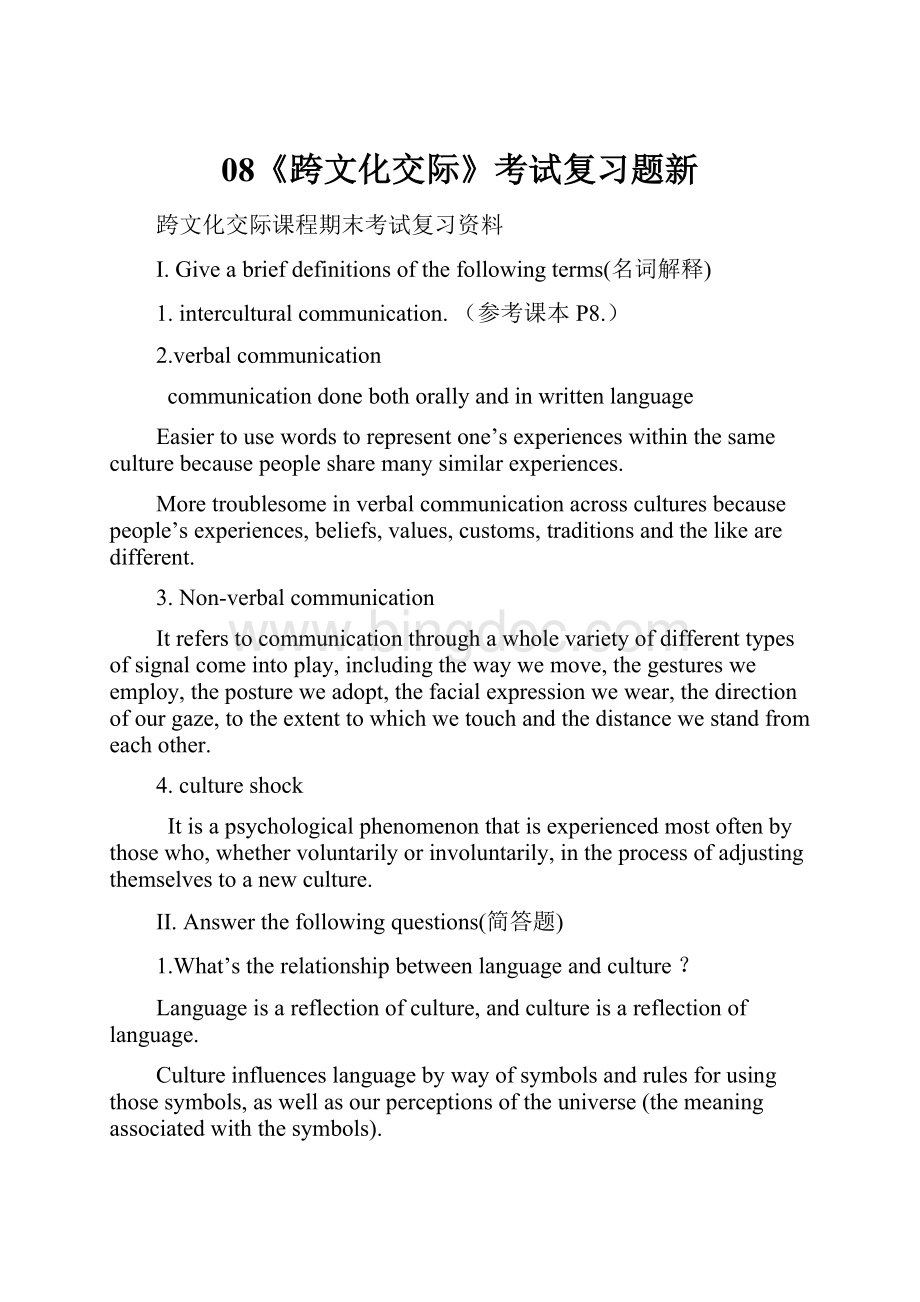08《跨文化交际》考试复习题新.docx
《08《跨文化交际》考试复习题新.docx》由会员分享,可在线阅读,更多相关《08《跨文化交际》考试复习题新.docx(16页珍藏版)》请在冰点文库上搜索。

08《跨文化交际》考试复习题新
跨文化交际课程期末考试复习资料
I.Giveabriefdefinitionsofthefollowingterms(名词解释)
1.interculturalcommunication.(参考课本P8.)
2.verbalcommunication
communicationdonebothorallyandinwrittenlanguage
Easiertousewordstorepresentone’sexperienceswithinthesameculturebecausepeoplesharemanysimilarexperiences.
Moretroublesomeinverbalcommunicationacrossculturesbecausepeople’sexperiences,beliefs,values,customs,traditionsandthelikearedifferent.
3.Non-verbalcommunication
Itreferstocommunicationthroughawholevarietyofdifferenttypesofsignalcomeintoplay,includingthewaywemove,thegesturesweemploy,thepostureweadopt,thefacialexpressionwewear,thedirectionofourgaze,totheextenttowhichwetouchandthedistancewestandfromeachother.
4.cultureshock
Itisapsychologicalphenomenonthatisexperiencedmostoftenbythosewho,whethervoluntarilyorinvoluntarily,intheprocessofadjustingthemselvestoanewculture.
II.Answerthefollowingquestions(简答题)
1.What’stherelationshipbetweenlanguageandculture?
Languageisareflectionofculture,andcultureisareflectionoflanguage.
Cultureinfluenceslanguagebywayofsymbolsandrulesforusingthosesymbols,aswellasourperceptionsoftheuniverse(themeaningassociatedwiththesymbols).
Language,ontheotherhand,wouldseemtohaveamajorimpactonthewayanindividualperceivesandconceptualizestheworld.
2.DescribethedifferentwaysinshowinghospitalitybetweenChinesecultureandwesternculture
Chineseguestsalwaysrefuseofferofdrinksorfoodtodemonstratepolitenessinseemingnottowishtoputtheirhosttoanytrouble.Sometimesanofferisnotarealofferbutapoliteremark.Afterwesay'no',weusuallywaitforthesecondandthirdoffer.Ifthehostjustbringsthefoodordrinkandignores'no',weillacceptit.Chineseliketopresstheirgueststodrinkoreattoshowtheirhospitality.Whilewesternersalwaysacceptorrefuseofferofdrinksorfoodverygenuinely.Theirrefusalisacceptedasgenuine.Westernersdon’tpress.Topresspeopletohavefoodordrinkaftertheyhaverefusedisfrowneduponandcancauseembarrassments.
3.WhatarethedifferencesonreceivinggiftsbetweenChineseandwesterner?
IntheWest,itisregardedaspolitetoopengiftsassoonastheyaregiventoexpressappreciation.InChina,thesituationisquitethereverse.NormallyweChinesefeelthatifyouopenthegiftassoonasitisgiven,youmightembarrassthepersonwhogivesthegiftandyoumightbethoughtgreedy.Therefore,Chinesepeopletendtoopenthegiftsafterthevisitorshaveleft.
InChina,manypeoplesendgiftswithoutwrappingthem,andiftheywrapthem,theyusuallytellthereceiverwhatisinside,andthereceiverwillthankthesenderandputthegiftasidewithoutunwrappingthemsincetheyalreadyknowwhatisinside.Englishreceiversopenthegiftsinfrontofthesendersofthegifts.
4.Explaintheterm“interculturalcommunicationcompetence”anditsthreecomponents.
Theinterculturalcompetencereferstotheabilitytounderstandandadaptthetargetculture.Interculturalcommunicativecompetenceinvolvescognitive,affectiveandoperationalaspects,whichareinseparableinreality.Theinterrelatednessofcognitive,affective,andoperationalcomponentsisveryimportantintheimprovementofthecommunicator’sinterculturalcommunicationcompetence.Therearealsothreeaspectsintermsofaffectivecomponents:
adaptationmotivation,Identityflexibilityandestheticco-orientation,thecognitiveaspectsofinterculturalcommunicationcompetencearethementalcapacitiesofcomprehensionandabilitytounderstandthemeaningsofvariousverbalandnonverbalcodes.OperationalcomponentsarethatIndividuals’capacitytoexpresscognitiveandaffectiveexperiencesoutwardlyisshownthroughspecificbehaviors.
5.WhydomanyChinesepeopletendtoaskaboutage,martialstatus,andevensalarywhenfirstmeetingoneanother?
Tothem,theseareopenconversationaltopics.Knowingaperson’sagehelpsthemuseappropriatetermsofaddress.AndChinesepeoplepayalotofattentiontofamilylife,sonaturallytalkoffamilymembersfeaturesasacommontopic.Astosalary,sincethereisanationalsystemofsalaries,peopleusuallydon’tconsideritasecretandtheytalkaboutitopenly.
6.HowtoaddresspeopleinbothChineseandEnglish?
(参考课本P22-24.)
7.WhatarethedifferencesbetweenChineseandEnglishKinTerms?
InChineseculture,peoplerefertopeoplestrictlyaccordingtothekinterms.Itiscompletelyunacceptabletorefertoone'sparentsbyusingthenames.Whenchildrenaddressrelatives,Chinesekintermstellwhethertheyareolderoryoungerthantheirfatherormother.Chinesekintermstellwhethertherelativesarefromthemother'orfather'ssideandwhetherone'sbrother,sisterorcousinisolderoryoungerthanhe/she.Chinesekintermsarealsotootherpeoplewhoarenotone'srelatives;kintermsarewidelyusedtoaddressknownorunknownpeople
WhileinEnglishculture,insomefamiliesinWesterncountries,somechildrenaddresstheirparentsdirectlybytheirfirstnames.InBritain,childrenareexpectedtoaddresstheparents'brotherandsisterswiththetitleofUncleorAuntplustheirnamesandsometimessimplyaddressthembyfirstnamewithoutatitle.Englishkintermsdon’ttellwhethertherelativesarefromthemother'orfather'sside,andtherearenotdistinctkintermsforelderbrotheroryoungerbrother.KintermsarenotasfrequentlyusedasinChinese.Inallkindsofsocialsituations,eitherformallyorinformally,peoplewon'tusekintermstoaddresseachotheriftheyarenotrelatives.
8.Statesixprinciplesforeffectivecross-gendercommunication.
8.WhatisthesignificanceofNonverbalCommunication?
Nonverbalbehaviorisasignificantareaofcommunicationstudyforatleastthree
reasons.
Nonverbalbehavioraccountsformuchofthemeaningwegetfromconversations.
Nonverbalbehaviorspontaneouslyreflectsthesubconsciousness.
Wecannotavoidcommunicatingthroughnonverbalsignals.
Besides,nonverbalbehaviorissignificantbecausenonverbalcommunicationcan
beopentomanyinterpretations.
9.Whydoweneedtostudyinterculturalcommunication?
(1).Technologicaldevelopment
Thedevelopmentofnewtransportationandinformationtechnologieshasconnectedallnationsinwaysthatwerepossiblebeforethiscenturyonlyintheimagination.
(2).WidespreadpopulationMigrations
(3).ThechangesintheinternationalbusinesscommunityhavecompelledChinatoreexamineherbusiness.
(4).DevelopmentofMulticulturalism.Culturaldiversityormulticulturalismwillbecomethenorm;nottheexception.Thepublicmustacknowledgeandadjusttodifferencebutbuildoncommonality.
10.whataremeaningsincommunication?
Utterancemeaning:
whatitnormallymeans
Speakersmeaning:
thespeakerhasintendedtoconveybywayofutterancemeaning.
Hearer’smeaning:
thehearerhasunderstoodonthebasisoftheutterancemeaning
Case:
AChinesestudenthadjustarrivedattheStates.Oneday,whenhewasreadinginhisroom,heheardsomeoneshoutingoutside:
“Watchout!
”Sohewenttothewindowandstretchedouthisheadandtriedtofindoutwhat’sgoingonoutside.Justthen,hisheadwasrightpouredbythewaterfromabove…
Question:
Wouldyoupleaseanalyzethesaying“Watchout”
withthethreemeaningsincommunication?
Keytothequestion:
1.Utterancemeaning:
Becareful!
2.Speaker’smeaning:
Don’tpullout!
3.Hearer’smeaning:
Somethingishappening!
Lookout!
11.Howtodeterminegeniusinvitingorfalseone?
1).Pleasereadthedialogue;trytounderstanditsfunction.
A:
Itwasnicetalkingtoyou.Ihavetoruntoclass.
B:
OK,maybewecanmeetsometimesoon.
A:
Yeah,I’dloveto.Whydon’tyoudropbymyhouse?
B:
Great.Gottogo.Seeyousoon.
ItisverycommondialogueamongAmericans.Itfunctionsasasignalforendinganinteractionorforanindicationoffriendliness.Itwillnotleadtodefinitefuturemeeting.
InAmericanculture,however,agenuineinvitationisalwaysmadewithclearindicationofactivity,timeandplaceorthemeeting.Thereisusuallyanegotiationaboutthetimeandplaceandadefinitereplyisexpected.
2).Nowstudythefollowingstatementsandthinkhowyouwouldrespondtoeachofthem.Discussinsmallgroups.
1.Let’sgettogethersoon.
2.Ihaven’tseenyouforalongtime.Youmustcomeroundfordinnersometime.
3.It’sgoodseeingyou.I’llinviteyoutotealater.
4.I’mgoingtogiveapartythisweekend.Comeifyoulike.
5.HowaboutjoiningusfordinnerthisFridaynight?
KeystoQuestion
1,2,and3,areunrealinvitations,becausethespeakerdoesn’tgivethespecifictimeandplacefortheget-together.You’dbetterreplylike“Thankyou.”“I’dlovetoverymuch.”Don’tquestionabout“when”or“where”,forthespeakerdoesn’treallymeantodoanyinvitation.
Statements4and5areinvitationastheygivespecifictime.ButtheymaysounduncertaintoaChineseearbecauseofthetoneoftheverbalinvitation.Easterners(Chinese)wouldmostlikelysaysomething.Like:
“Docome.Pleasedocome.”
3).Summary
Paymoreattentiontothefeaturesof“false”invitation.
1.Indefinitereferenceoftime,place.
2.Noinquiryorimmediatereplyordecision.
3.Adverbsindicatingtheuncertaintyoftimelike:
“Oneday”,”Someday”,“soon”etc.
PartIIICaseAnalysis(Youarerequiredtostateculturalphenomenonineachcase)
Case1
XiaoLIandXiaoWangwerecolleagues.XiaoLIgavealotofhelptoXiaoWangfinanciallyandsocially.RecentlyXiaoLIwouldgetmarried.Butheforg